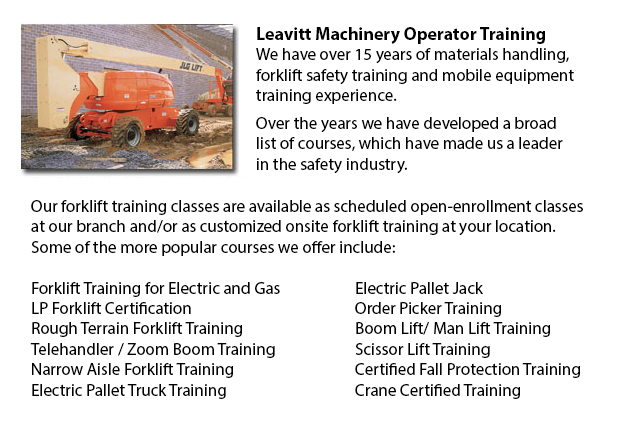
Boom Lift Safey Training BC - Boom lifts fall under the type of elevated work platform or aerial lifting device. Most commonly used in industry, warehousing and construction; the boom lift is very versatile that it can be used in almost whatever setting.
Elevated work platforms allow workers to get into work places which will be not reachable otherwise. There is inherent risk in the operation of these devices. Employees who operate them must be trained in the proper operating techniques. Accident prevention is vital.
The safety factors which are involved in using boom lifts are covered in our Boom Lift Training Programs. The course is suitable for people who operate self-propelled boom supported elevated work platforms and self-propelled elevated work platforms. Upon successful completion of the course, Those who participated would be issued a certificate by a person who is licensed to verify finishing a hands-on evaluation.
To be able to help train operators in the safe use of elevated work platforms, industry agencies, local and federal regulators, and lift manufacturers all play a part in providing the necessary information and establishing standards. The most important ways in preventing accidents related to the use of elevated work platforms are the following: inspecting machinery, having on safety gear and conducting site assessment.
Key safety factors when operating Boom lifts:
Operators have to observe the minimum safe approach distance (or also called MSAD) from power lines. Voltage can arc across the air to find an easy path to ground.
To be able to maintain stability when the platform nears the ground, a telescopic boom must be retracted before lowering a work platform.
Boom lift workers should tie off to ensure their safety. The harness and lanyard tools must be connected to manufacturer provided anchorage, and never to other poles or wires. Tying off may or may not be necessary in scissor lifts, depending on specific job risks, local regulations, or employer guidelines.
Avoid working on a slope which exceeds the maximum slope rating as specified by the manufacturer. If the slop goes beyond requirements, therefore the equipment should be winched or transported over the slope. A grade could be simply measured by laying a minimum 3-feet long straight edge or board on the slope. Afterward a carpenter's level can be laid on the straight edge and raising the end until it is level. The percent slope is obtained by measuring the distance to the ground (likewise known as the rise) and then dividing the rise by the length of the straight edge. Afterward multiply by 100.
-
Zoom Boom Ticket BC
Zoom Boom Ticket BC - Zoom Boom Training focuses on correctly training prospective operators on variable reach forklifts. The training objectives include gaining the understanding of the equipments physics and to be able to define the job of the oper... More -
Scissor Lift Training BC
Scissor Lift Training BC - When operating a scissor lift, they should be used competently in order to protect the wellbeing of the other personnel in the workplace and to protect the safety of the equipment. Operators who are skilled are trained to d... More -
Wheel and Track Loader Training in BC
Lift trucks are obtainable in several load capacities and several models. Nearly all forklifts in a regular warehouse surroundings have load capacities between one to five tons. Bigger scale models are used for heavier loads, like loading shipping co... More -
Zoom Boom Training BC
Zoom Boom Training BC - Zoom Boom Training focuses on properly training prospective operators on variable reach forklifts. The training goals consist of gaining the knowledge of the machine's physics and to define the responsibilities of the operator... More -
Heavy Equipment Operator Certification BC
Heavy Equipment Operator Certification BC - The heavy equipment operator is a person who manipulates the controls and drives various types of huge machinery. Heavy machinery is most commonly used on construction sites to deliver supplies to the site... More -
Crane Ticket BC
Crane Ticket BC - New cranes can either be complex or simple, based on the nature of the application they are able to do. For example, mobile cranes are rather simple models. A steel truss and even a telescopic boom mounts its movable platform. A sys... More -
Telehandler Training in BC
Telescopic handlers normally known as telehandlers for short, are a very popular piece of heavy construction machinery. They are commonly utilized in the construction and agricultural industries. These equipments have maximum reaching capacity and ar... More -
Wheel Loader Training BC
Wheel Loader Training BC - Normally, the various types of heavy equipment training are divided into 2 categories of equipment: those which have rubber tires and tracked vehicles. Tracked vehicles comprise items like excavators, cranes, and bulldozers... More

Forklift Training BC
TOLL FREE: 1-888-254-6157
forkliftcertificationbritishcolumbia.com
Email Us
About Us


